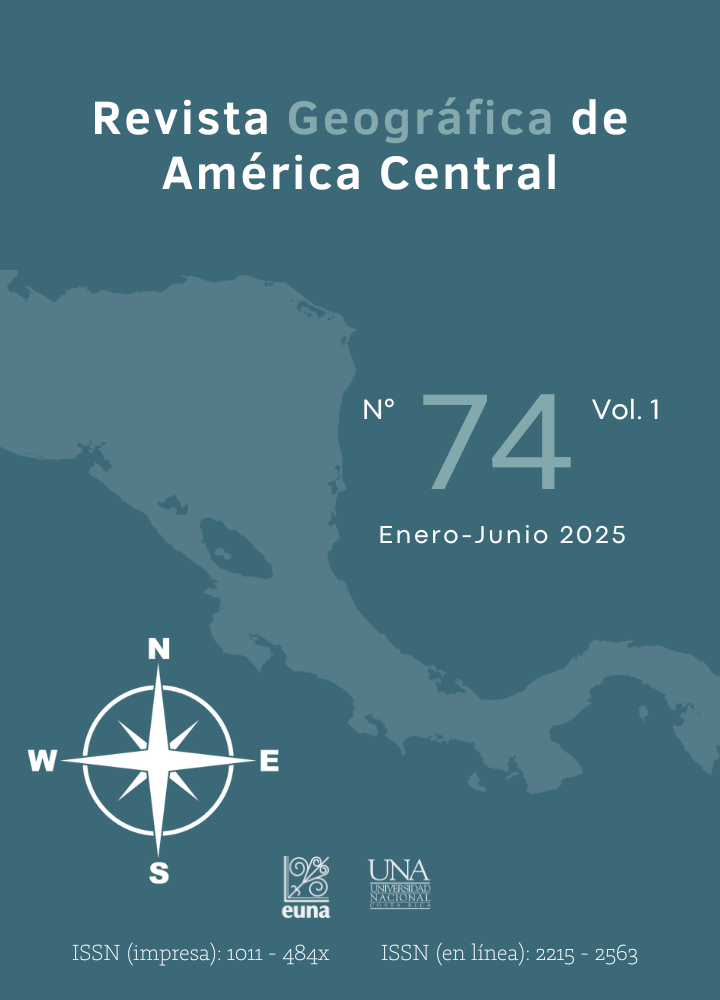ASSESSMENT OF THE LANDSCAPE FOR THE SUSTAINABLE DEVELOPMENT OF TOURISM IN THE COMMUNITY OF SAN FRANCISCO, ECUADOR
DOI:
https://doi.org/10.15359/rgac.74-1.3Keywords:
Visual quality, landscape fragility, landscape evaluation, sustainable tourism, sustainable developmentAbstract
The community of San Francisco, located in the province of Manabí, Ecuador, faces the challenge of developing tourism sustainably in a natural environment. This research aims to conduct a descriptive assessment of its landscape value, in order to support landscape preservation and guide tourism activity planning in the region. The methodology involved data collection through online surveys, field evaluations, and collaboration with the local community. Findings revealed the delineation of five landscape units based on land use: natural forest, anthropized natural forest, agriculture, cultivated pasture, and the San Francisco community. The high visual quality and moderate landscape fragility demonstrate the great potential for tourism under careful planning and management. It is crucial to promote tourism activities focused on appreciating nature and scenic beauty, such as hiking, cycling, camping, and agrotourism, to foster a balance between environmental conservation and sustainable development. Additionally, integrating local products into the culinary offerings aimed at tourists serves as a means to support and bolster the local economy.
References
Bureau of Land Management. (1980). Visual Simulation Techniques. Manual 8400. Government Printing Office. BLM https://www.blm.gov/programs/recreation/recreation-programs/visual-resource-management
Burger, J. (2000). Landscapes, tourism, and conservation. Science of the total environment, 249(1-3), 39-49.
Chazari, D; Castellanos, M; Reynoso, C. (2020). Lectura y valoración del paisaje conventual franciscano de Cuauhtinchán, Puebla. Topofilia, (21), 283-307.
https://topofilia.buap.mx/index.php/topofilia/article/view/113
Fernández, C. (2020). El paisaje lingüístico de un área urbana de transición del español y el vasco: identidades y símbolos. Bulletin Hispanique, 1(122), 325-344. https://www.cairn.info/revue-bulletin-hispanique-2020-1-page-325.htm
Fernández, F; Garza, G. (2006). La pintura geográfica en el siglo XVI y su relación con una propuesta actual de la definición de “paisaje”. Scripta Nova. Revista electrónica de geografía y ciencias sociales, 10(218), s.p. https://www.ub.edu/geocrit/sn/sn-218-69.htm
Gandarillas, M; McCall, M. (2023). Ecocultural networks as grounds for spatial planning. A psychosocial approach applied to coastal development. Journal of Cultural Heritage Management and Sustainable Development, 13(1), 108-122. https://doi.org/10.1108/JCHMSD-01-2021-0008
Mateo, J. (2008). Geografía de los paisajes. Primera parte: paisajes naturales. Editorial Universitaria, Cuba.
Méndez A; Serrano, M; Salinas, E; García, A. (2018). Propuesta metodológica basada en indicadores para la valoración del potencial turístico del paisaje en áreas rurales: el caso del municipio de Atlautla (México). Cuadernos de Turismo, (42), 335-354. http://dx.doi.org/10.6018/turismo.42.15
Muñoz, A. (2004). La evaluación del paisaje: una herramienta de gestión ambiental. Revista chilena de historia natural, 77(1), 139-156. http://dx.doi.org/10.4067/S0716-078X2004000100011
Nogué, J. (1989). Paisaje y turismo. Estudios Turísticos, (103), 35-45. https://dugi-doc.udg.edu/handle/10256/4101
Petit, S; Alignier, A; Allart, R; Aviron, S; Boussard, H; Franck, P; Gibert, C; Ladet, S; Lavigne, C; Lecuyer, L; Moncamp, M; Muneret, L; Poggi, S; Ricci, B; Rusch, A; Vialatte, A; Young, J. (2023). Building capacities for the design of agroecological landscapes: The added-value of Landscape Monitoring Networks. Agriculture, Ecosystems & Environment, (342), s.p. https://doi.org/10.1016/j.agee.2022.108263
Salinas, E; Teixeira dos Santos, E; Ribeiro, L; Perbelin, L. (2023). Valoración estética de los paisajes de interés turístico: caso de estudio Carretera-Parque Piraputanga-Aquidauana-Mato Groso del Sur–Brasil. Revista Geográfica de América Central, 1(70), 377-402. https://www.revistas.una.ac.cr/index.php/geografica/article/view/16621/26658
Smalley, A; White, M. (2023). Beyond blue-sky thinking: Diurnal patterns and ephemeral meteorological phenomena impact appraisals of beauty, awe, and value in urban and natural landscapes. Journal of Environmental Psychology, (86), s.p. https://doi.org/10.1016/j.jenvp.2023.101955
Suárez, R. (2014). El paisaje como recurso turístico en las áreas naturales protegidas: caso reserva de la Biosfera Janos, Chihuahua, México. NovaRua Revista Universitaria de Administración, 4(9), 5-13. https://doi.org/10.20983/novarua.2014.9
Thompson, M; Prideaux, B; McShane, C; Dale, A; Turnour, J; y Atkinson, M. (2016) Tourism development in agricultural landscapes: the case of the Atherton Tablelands, Australia, Landscape Research, 41(7), 730-743, https://doi.org/10.1080/01426397.2016.1174839
Yeomans, W. (1986). Visual Impact Assessment: Changes in natural and rural environment. Foundations for Visual Project Analysis, John Willey & Sons, New York.
Downloads
Published
How to Cite
Issue
Section
License
Copyright (c) 2025 Sonia Rosete Blandariz, Humberto Antonio González González, Humberto Antonio González González, Genessis Isabel Reina Perez, Genessis Isabel Reina Perez, Romina Stephania Sáenz Véliz, Romina Stephania Sáenz Véliz

This work is licensed under a Creative Commons Attribution-NonCommercial-ShareAlike 4.0 International License.
Proposed policy for journals offering Open Access
Authors publishing their works in the Journal acknowledge and agree to the following terms:
a) Authors retain the copyrights to their works and guarantee the Journal the right to be the first to publish their works, under the Creative Commons License Attribution-NonCommercial-ShareAlike 4.0 International, CC BY-NC-SA 4.0 International (https://creativecommons.org/licenses/by-nc-sa/4.0/deed.es), which allows others to share works upon complying with the acknowledgment of authorship and mention of the Journal as the original publisher of the work.
b) Authors are permitted to separately establish additional agreements for the non-exclusive distribution of the official edition of the work published in the Journal (for example, authors may desire to place the work in an institutional repository or incorporate it into a book that is to published elsewhere) so long they acknowledgment to recognize the Journal as the original publisher. The aforementioned additional agreements must respect the terms of the non-profit character and sharing philosophy of the original license (CC BY-NC-SA 4.0 International, https://creativecommons.org/licenses/by-nc-sa/4.0/deed.es).
c) Authors are encouraged to archive the post-print or editor/PDF version in Open Access repositories.






 REVGEO is licensed under https://creativecommons.org/licenses/by-nc-sa/4.0/deed.es
REVGEO is licensed under https://creativecommons.org/licenses/by-nc-sa/4.0/deed.es
.svg_4.png)

_(1).png)
_(1)_(1)_(1)_1.png)
(2)(1)(1)(1).png)
